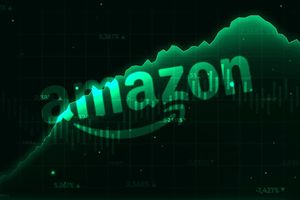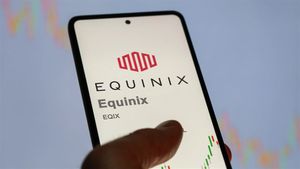
U.S. stock futures have surged in late October 2025, buoyed by stellar earnings reports and subsequent rallies from tech giants Apple (NASDAQ: AAPL) and Amazon (NASDAQ: AMZN). This significant uplift in the technology sector has not only reignited investor confidence but is also sending subtle yet profound ripples through the broader financial landscape, indirectly influencing commodity demand and recalibrating overall market sentiment. The performance of these market behemoths is increasingly seen as a bellwether, signaling underlying economic currents that could reshape investment strategies in the coming months.
The immediate implication of these tech-fueled gains is a renewed sense of optimism in a market that has navigated a complex tapestry of geopolitical concerns, cautious central bank stances, and domestic policy uncertainties. While the direct link to commodity prices might not be immediately apparent, the sustained growth demonstrated by Apple and Amazon, particularly in areas like AI infrastructure and resilient consumer spending, suggests a robust economic environment that could drive demand for essential raw materials and energy, albeit with sector-specific nuances.
Tech Giants Propel Market Forward Amidst Volatility
The catalyst for this latest market surge was a series of robust quarterly earnings reports released in late October 2025. Amazon (NASDAQ: AMZN) spearheaded the charge, with its shares skyrocketing by 12-13% in extended and premarket trading. This impressive leap was primarily attributed to the accelerated growth of its cloud computing unit, Amazon Web Services (AWS), which recorded its fastest expansion in nearly three years. The surge in AWS demand was largely fueled by burgeoning artificial intelligence (AI) initiatives across various industries, positioning Amazon's stock to open at a record high and underscoring the profound impact of AI on corporate profitability.
Following suit, Apple (NASDAQ: AAPL) also delivered an upbeat performance, with its stock rising by 2-3% after surpassing revenue estimates and providing an optimistic forecast for the crucial holiday quarter. This positive outlook was underpinned by strong global demand for its latest flagship device, the iPhone 17, and record-high services revenue, solidifying its position as a dominant force in consumer electronics and digital services. Apple's market capitalization notably crossed the $4 trillion mark during this period, a testament to its enduring brand power and innovative product pipeline.
The combined force of these tech titans had an immediate and palpable effect on U.S. stock futures. On October 31, 2025, S&P 500 futures rose by 0.5-0.8%, while Nasdaq 100 futures gained an even more impressive 1.0-1.3%. These gains offered a much-needed respite and reignited the broader tech rally, coming on the heels of a challenging trading session on the preceding Thursday (October 30) where other major technology companies, including Microsoft (NASDAQ: MSFT) and Nvidia (NASDAQ: NVDA), had experienced declines due to mixed earnings and lingering investor concerns over the high costs associated with AI investments. The market's quick rebound, largely thanks to Apple and Amazon, underscored the selective nature of investor confidence within the tech sector, favoring companies demonstrating clear profitability and growth trajectories in key areas like AI and premium consumer segments.
Companies Poised for Gains and Potential Headwinds
The ripple effects of the Apple (NASDAQ: AAPL) and Amazon (NASDAQ: AMZN) rallies extend far beyond the immediate tech sector, creating a dynamic environment where certain companies are poised for significant gains while others might face indirect headwinds. The underlying economic signals—driven by AI investment and resilient consumer spending—are key to identifying these potential winners and losers.
On the winning side, semiconductor manufacturers and data center infrastructure providers stand to benefit immensely. The accelerated growth of Amazon Web Services (AWS) driven by AI demand directly translates to increased orders for advanced chips from companies like Taiwan Semiconductor Manufacturing Company (NYSE: TSM) and ASML Holding (NASDAQ: ASML), which provide the lithography equipment necessary for chip production. Similarly, companies that build and maintain data centers, such as Equinix (NASDAQ: EQIX) and Digital Realty Trust (NYSE: DLR), will likely see sustained demand for their services as tech giants expand their AI infrastructure. Furthermore, industrial metal producers, particularly those focused on copper, could see an indirect boost. The massive build-out of AI infrastructure requires vast amounts of copper for electrical wiring, cooling systems, and power transmission. Companies like Freeport-McMoRan (NYSE: FCX) and Southern Copper Corporation (NYSE: SCCO) could experience increased demand, especially as global industrial activity picks up outside of China in the latter half of 2025. The overall optimistic market sentiment, coupled with potential future interest rate cuts, could also encourage spending in capital-intensive sectors, slowly improving global metal demand.
Conversely, companies heavily reliant on discretionary consumer spending from lower-income demographics might face continued challenges. While Apple's strong performance indicates resilience in the premium consumer segment, the research highlighted a "clear bifurcation" between higher and lower-income consumers. Retailers catering to budget-conscious shoppers, such as certain discount chains or apparel companies, could experience slower growth if economic pressures persist for this segment. Additionally, traditional energy companies, particularly those focused on crude oil production, may face ongoing headwinds. The research indicates that crude oil prices are forecast to experience downward pressure through 2025 due to global production outgrowing demand, despite efforts by OPEC+ to manage output. Companies like ExxonMobil (NYSE: XOM) and Chevron (NYSE: CVX), while diversified, could feel the squeeze of persistent oversupply in the oil market. Lastly, companies with high debt loads or those in interest-rate-sensitive sectors could still face pressure if the Federal Reserve maintains a cautious stance on future rate cuts, making borrowing more expensive and hindering expansion plans, even amidst broader market optimism.
Broader Implications: AI's Economic Rewiring and Global Shifts
The recent surge in U.S. stock futures, largely orchestrated by the robust performance of Apple (NASDAQ: AAPL) and Amazon (NASDAQ: AMZN), signifies more than just a momentary market rally; it underscores a profound shift in broader industry trends and economic dynamics. At its core, this event highlights the accelerating influence of Artificial Intelligence (AI) as a primary economic driver. The significant growth in Amazon Web Services (AWS), directly attributed to AI demand, illustrates how AI is not merely a technological advancement but a fundamental re-wiring of economic infrastructure, driving massive corporate investment in data centers, advanced computing, and related services. This trend fits into a larger narrative of digital transformation, where companies that successfully leverage AI are gaining a competitive edge, leaving those slow to adapt at a disadvantage.
The potential ripple effects are extensive. Competitors in the cloud computing space, such as Microsoft Azure (NASDAQ: MSFT) and Google Cloud (NASDAQ: GOOGL), are likely to intensify their AI-focused investments and offerings to keep pace with Amazon's accelerated growth. This competitive intensity could lead to further innovation but also higher capital expenditures across the industry. For partners, particularly those in the semiconductor and hardware sectors, the sustained demand from tech giants like Apple and Amazon translates into consistent order flows and opportunities for technological collaboration. Companies like TSMC (NYSE: TSM) and other chip manufacturers are direct beneficiaries of this AI-driven expansion. Furthermore, the resilience in consumer spending, particularly for premium products like the iPhone 17, suggests that high-end consumer markets remain robust, potentially benefiting luxury brands and high-value service providers.
Regulatory and policy implications are also emerging from this tech-led surge. As AI becomes more pervasive, governments globally are increasingly scrutinizing data privacy, algorithmic bias, and market concentration within the tech sector. The substantial market capitalization of companies like Apple, now exceeding $4 trillion, could attract further antitrust attention, potentially leading to new regulations aimed at fostering competition and protecting consumers. Historically, periods of rapid technological advancement and market concentration have often prompted regulatory responses, and this current AI-driven boom is unlikely to be an exception. Comparisons can be drawn to the dot-com bubble of the late 1990s, where speculative investment in nascent internet technologies led to eventual market corrections and a re-evaluation of business models. However, the current AI growth appears to be underpinned by more tangible corporate investment and demonstrable revenue growth, suggesting a more sustainable, albeit still rapidly evolving, paradigm shift. The U.S.-China trade truce, mentioned in the research, also plays a role, easing some geopolitical concerns that could otherwise dampen tech sector growth and global supply chains.
The Path Forward: Strategic Adaptations and Emerging Opportunities
Looking ahead, the market's trajectory, heavily influenced by the sustained performance of tech leaders like Apple (NASDAQ: AAPL) and Amazon (NASDAQ: AMZN), presents a nuanced outlook with both short-term and long-term possibilities. In the short term, the prevailing market sentiment is likely to remain cautiously optimistic, with investors continuing to favor companies demonstrating clear growth pathways, particularly those with strong AI integration or exposure to resilient consumer segments. This could lead to continued outperformance of mega-cap tech stocks, potentially creating a "barbell" market where a few dominant players drive overall index gains while other sectors struggle for momentum.
For businesses, strategic pivots and adaptations will be crucial. Companies across all industries must assess their AI readiness and investment strategies. Those that fail to integrate AI effectively into their operations risk falling behind, while those that embrace it can unlock new efficiencies, enhance product offerings, and tap into new revenue streams. This necessitates significant capital allocation towards technological upgrades and talent acquisition. Market opportunities are likely to emerge in specialized AI services, cybersecurity solutions to protect burgeoning data centers, and advanced materials for next-generation computing infrastructure. The increased corporate investment in AI infrastructure, as highlighted by Amazon's capital expenditure forecasts, suggests a robust demand for these ancillary services and products.
In the long term, the sustained AI boom could lead to significant productivity gains across the economy, potentially driving a new era of economic growth. However, challenges also loom. The "clear bifurcation" in consumer spending, where higher-income individuals continue to spend while lower-income segments face pressure, suggests that economic recovery might be uneven. This could exacerbate wealth inequality and potentially lead to social and political ramifications. Furthermore, the massive capital expenditure by tech giants, while stimulating growth, raises questions about potential overinvestment and future returns on these colossal AI bets. Scenarios range from a sustained tech-led bull market, where innovation continues to drive economic expansion, to a more volatile environment if AI investments fail to meet lofty expectations or if regulatory pressures intensify. The ongoing cautious stance from the Federal Reserve on interest rate cuts also remains a critical factor, as higher borrowing costs could eventually temper corporate expansion plans.
Concluding Thoughts: A Tech-Driven Horizon with Nuanced Undercurrents
The recent surge in U.S. stock futures, propelled by the remarkable rallies of Apple (NASDAQ: AAPL) and Amazon (NASDAQ: AMZN), serves as a potent reminder of the technology sector's enduring dominance and its profound influence on the broader financial markets. The key takeaways from this event are multi-faceted: the undeniable power of AI as a growth engine, the resilience of premium consumer spending, and the resulting recalibration of market sentiment towards cautious optimism. While these tech giants continue to break records and drive indices higher, their performance is also signaling deeper economic trends, including massive corporate investment in digital infrastructure and a potential divergence in consumer economic health.
Moving forward, the market is poised to remain highly dynamic, with investors closely watching for continued innovation in AI, the evolution of consumer spending patterns across different income brackets, and the monetary policy decisions of central banks. The indirect impact on commodity markets will also be a critical area of observation; while crude oil faces headwinds, industrial metals, particularly copper, could see sustained demand fueled by the ongoing build-out of AI infrastructure. Gold, meanwhile, is expected to retain its safe-haven appeal amidst lingering uncertainties.
Ultimately, the significance of this tech-led rally lies in its ability to both reflect and shape the future economic landscape. It underscores a period of rapid technological advancement and substantial capital reallocation, promising both significant opportunities and potential challenges. Investors should watch for the sustainability of AI-driven growth, any shifts in consumer confidence, and the broader geopolitical and regulatory environment. The coming months will reveal whether this tech-fueled optimism can translate into broad-based economic prosperity or if the market will continue to be driven by a select few, albeit powerful, industry leaders.
This content is intended for informational purposes only and is not financial advice






